Cuban macaw
| Cuban macaw | |
|---|---|
 | |
| Painting by Jacques Barraband, ca. 1800 | |
| Scientific classification | |
| Kingdom: | Animalia |
| Phylum: | Chordata |
| Class: | Aves |
| Order: | Psittaciformes |
| Superfamily: | Psittacoidea |
| Family: | Psittacidae |
| Subfamily: | Arinae |
| Tribe: | Arini |
| Genus: | Ara |
| Species: | A. tricolor |
| Binomial name | |
| Ara tricolor Bechstein, 1811 | |
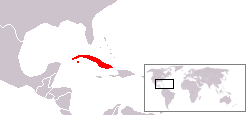 | |
| Location of Cuba and Isla de la Juventud | |
| Synonyms | |
| |
The Cuban macaw or Cuban red macaw (Ara tricolor) was a species of macaw native to the main island of Cuba and the nearby Isla de la Juventud that became extinct in the late 19th century. Its relationship with other macaws in the genus Ara is uncertain, but it may have been closely related to the scarlet macaw, which has some similarities in appearance. It may also have been closely related, or identical, to the hypothetical Jamaican red macaw. No modern skeletons are known, but a few subfossil remains have been found on Cuba.
At about 45–50 centimetres (18–20 in) long, the Cuban macaw was one of the smallest macaws. It had a red, orange, yellow, and white head, and a red, orange, green, brown, and blue body. Little is known of its behaviour, but it is reported to have nested in hollow trees, lived in pairs or families, and fed on seeds and fruits. The species' original distribution on Cuba is unknown, but it may have been restricted to the central and western parts of the island. It was mainly reported from the vast Zapata Swamp, where it inhabited open terrain with scattered trees.
The Cuban macaw was traded and hunted by Amerindians, and by Europeans after their arrival in the 15th century. Many individuals were brought to Europe as cagebirds, and 19 museum skins exist today. It had become rare by the mid-19th century due to pressure from hunting, trade, and habitat destruction. Hurricanes may also have contributed to its demise. The last reliable accounts of the species are from the 1850s on Cuba and 1864 on Isla de la Juventud, but it may have persisted until 1885.
Taxonomy
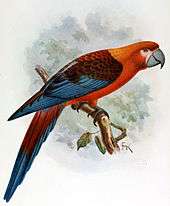
Early explorers of Cuba, such as Christopher Columbus and Diego Álvarez Chanca, mentioned macaws on Cuba in 14th- and 15th-century writings. Cuban macaws were described and illustrated in several early accounts about the island.[2] In 1811, Johann Matthäus Bechstein scientifically named the species Psittacus tricolor.[3] Bechstein's description was based on the bird's entry in François Le Vaillant's 1801 book Histoire Naturelle des Perroquets.[4][5] Le Vaillant's account was itself partially based on the late 1700s work Planches Enuminées and a specimen in Paris; as it is unknown which specimen this was, the species has no holotype. Jacques Barraband's original watercolour painting which was the basis of the plate in Le Vaillant's book differs from the final illustration in showing bright red lesser wing covert feathers ("shoulder" area), but the significance of this is unclear.[6]
Today, 19 skins of the Cuban macaw exist in 15 collections worldwide (two each in Natural History Museum at Tring, Muséum national d'histoire naturelle in Paris, the Swedish Museum of Natural History, and the Smithsonian Museum), but many are of unclear provenance. Several were provided by Juan Gundlach, who collected some of the last individuals that regularly fed near the Zapata Swamp in 1849–50. Some of the preserved specimens are known to have lived in captivity in zoos (such as Jardin des Plantes de Paris, Berlin Zoo, and Amsterdam Zoo) or as cagebirds. Several more skins are known to have existed, but have been lost.[2] There are no records of its eggs.[7]
No modern skeletal remains are known, but three subfossil specimens have been discovered: half a carpometacarpus from a possibly Pleistocene spring deposit in Ciego Montero, identified by extrapolating from the size of Cuban macaw skins and bones of extant macaws (reported in 1928), a rostrum from a Quaternary cave deposit in Caimito (reported in 1984), and a worn skull from Sagua La Grande, which was deposited in a waterfilled sinkhole possibly during the Quaternary and associated with various extinct birds and ground sloths (reported in 2008).[8][9]
As many as 13 now-extinct species of macaw have variously been suggested to have lived on the Caribbean islands, but many of these were based on old descriptions or drawings and only represent hypothetical species. Only three endemic Caribbean macaw species are known from physical remains: the Cuban macaw, the Saint Croix macaw (Ara autochthones), which is known only from subfossils, and the Lesser Antillean macaw (Ara guadeloupensis), which is known from subfossils and reports.[10][11] Macaws are known to have been transported between the Caribbean islands and from mainland South America to the Caribbean both in historic times by Europeans and natives, and in prehistoric times by Paleoamericans. Historical records of macaws on these islands, therefore, may not have represented distinct, endemic species; it is also possible that they were escaped or feral foreign macaws that had been transported to the islands.[10] All the endemic Caribbean macaws were likely driven to extinction by humans in historic and prehistoric times.[9] The identity of these macaws is only likely to be further resolved through fossil finds and examination of contemporary reports and artwork.[2]
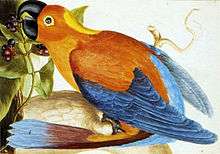
The Jamaican red macaw (Ara gossei) was named by Walter Rothschild in 1905 on the basis of a description of a specimen shot in 1765. It was described as being similar to the Cuban macaw, mainly differing in having a yellow forehead. Some researchers believe the specimen described may have been a feral Cuban macaw.[2] A stylised 1765 painting of a macaw by Lieutenant L. J. Robins, published in a volume called The Natural History of Jamaica, matches the Cuban macaw, and may show a specimen that had been imported there; however, it has also been claimed that the painting shows the Jamaican red macaw.[10][12] Rothschild's 1907 book Extinct Birds included a depiction of a specimen in the Liverpool Museum which was presented as a Cuban macaw. In a 1908 review of the book published in The Auk, the reviewer claimed that the picture looked sufficiently dissimilar from known Cuban macaws that the specimen may actually be of one of the largely unknown species of macaw, such as a species from Haiti.[13] The reviewer's objection has not been accepted.[2]
In 1985, David Wetherbee suggested that extant specimens of the Cuban macaw had come from both Cuba and Hispaniola, based on his interpretation of an 1888 report. He believed the name Ara tricolor applied to the supposed Hispaniolan species, and therefore coined the new name Ara cubensis for the Cuban species. This hypothesis has not been accepted by other researchers, and there is no clear evidence for a species of macaw on Hispaniola.[2] The trinomial name Ara tricolor haitius was coined for a supposed Hispaniolan macaw by Dieter Hoppe in 1983, but is now considered to have been based on erroneous records.[14]
Since detailed descriptions of extinct macaws exist only for the species on Cuba, it is impossible to determine the species' relationships.[2] It has been suggested that the closest mainland relative of the Cuban macaw is the scarlet macaw (Ara macao), due to the similar distribution of red and blue in their plumage, and the presence of a white patch around the eyes, naked except for lines of small red feathers. Furthermore, the range of the scarlet macaw extends to the margins of the Caribbean Sea. The Cuban macaw is distinct due to its lack of a yellow shoulder patch, its all-black beak, and its smaller size.[9] The two also share a species of feather mite, which supports their relationship.[2] James Greenway believed the scarlet macaw and the Cuban macaw formed a superspecies with the other extinct species suggested to have inhabited Jamaica, Hispaniola and Guadeloupe.[15]
Description
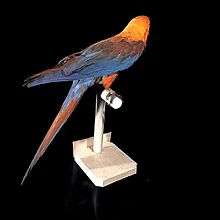
The Cuban macaw had a red forehead fading to orange and then to yellow at the nape of the neck. It had white unfeathered areas around the eyes, and yellow irises. The face, chin, chest, abdomen and thighs were orange. The legs were brown. The upper back was brownish red with feathers scalloped with green. The rump, undertail feathers, and lower back were blue. The wing feathers were brown, red and purplish blue. The upper surface of the tail was dark red fading to blue at the tip, and the under surface of the tail was brownish red.[7] The beak has variously been described as dark, all-black, and greyish black.[2][7][14] The sexes were identical in external appearance, as with other macaws.[15]
About 50 centimetres (20 in) long, the Cuban Macaw was a third smaller than its largest relatives. The wing was 275–290 millimetres (10.8–11.4 in) long, the tail was 215–290 millimetres (8.5–11.4 in), the culmen 42–46 millimetres (1.7–1.8 in), and the tarsus 27–30 millimetres (1.1–1.2 in). The subfossil cranium shows that the length between the naso-frontal hinge and the occipital condyle was 47.0 millimetres (1.85 in), the width across the naso-frontal hinge was about 25.0 millimetres (0.98 in), and the width of the postorbital processes was about 40 millimetres (1.6 in). Details of the skull were similar to other Ara species.[7][8]
Austin Hobart Clark reported that juvenile Cuban macaws were green, though he did not provide any source for this claim. It is unclear whether green birds spotted on the island were in fact juvenile Cuban macaws or if they were instead feral military macaws (Ara militaris).[2][16]
Behaviour and ecology

Little is known about the behaviour of the Cuban macaw and its extinct Caribbean relatives. Gundlach reported that it vocalised loudly like its Central American relatives and that it lived in pairs or families. Its speech imitation abilities were reportedly inferior to those of other parrots. Nothing is known about its breeding habits or its eggs, but one reported nest was a hollow in a palm.[2]
The skull roof of the subfossil cranium was flattened, indicating the Cuban macaw fed on hard seeds, especially from palms. This is consistent with the habits of their large relatives on mainland South America and distinct from those of smaller, mainly frugivorous relatives. In 1876, Gundlach wrote that the Cuban macaw ate fruits, seeds of the royal palm (Roystonea regia) and the chinaberry tree (Melia azedarach), as well as other seeds and shoots. Cuba has many species of palms, and those found in swamps were probably most important to the Cuban macaw.[8] The pulp surrounding the seeds of the chinaberry tree were probably the part consumed by the Cuban macaw.[2]
In 2005, a new species of chewing louse, Psittacobrosus bechsteini, was described based on a dead specimen discovered on a museum skin of the Cuban macaw.[17] It is thought to have been unique to this species, and is therefore an example of coextinction.[14] The feather mite species Genoprotolichus eurycnemis and Distigmesikya extincta have also been reported from Cuban macaw skins, the latter new to science.[2]
Distribution and habitat
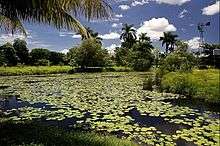
The breadth of the Cuban macaw's distribution the time of European settlement on the main island of Cuba is unclear, but the species was reportedly becoming rare by the mid-19th century. It may have been restricted to the central and western part of Cuba. Most accounts from the 19th century are based on Gundlach's reports from the immense Zapata Swamp, where the species was somewhat common near the northern edge. By the 1870s, it was becoming rarer and had retreated to the interior.[2] The subfossil skull from Sagua La Grande is the northernmost and easternmost record of the Cuban macaw. One subfossil rostrum was found in a cave. Caves are usually not visited by macaws, but the surrounding region is possibly a former swamp.[8] The Cuban macaw had also inhabited Isla de la Juventud (previously called the Isle of Pines) off Cuba, but Outram Bangs and W. R. Zappey reported that the last pair was shot near La Vega in 1864.[18] Early writers also claimed it lived on Haiti and Jamaica, but this is no longer accepted.[2]
The habitat of the Cuban macaw was open savanna terrain with scattered trees, typical of the Zapata Swamp area. Cuba was originally widely covered in forest, much of which has since been converted to cropland and pastures. Lomas de Rompe, where the macaw was also reported, had rainforest-like gallery forest.[2]
Extinction
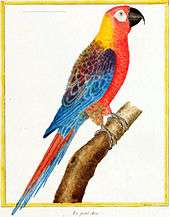
Hunting has been proposed as a factor in the extinction of the Cuban macaw. Parrots were hunted, kept as pets, and traded by Amerindians in the Caribbean before the arrival of Europeans. The Cuban macaw was reportedly "stupid" and slow to escape, and therefore was easily caught. It was killed for food; Gemelli Careri found the meat tasty, but Gundlach considered it tough.[2] Archaeological evidence suggests the Cuban macaw was hunted in Havana in the 16th–18th centuries.[8] It may also have been persecuted as a crop pest, though it did not live near dwellings.[2]
In addition to being kept as pets locally, many Cuban macaws (perhaps thousands of specimens) were traded and sent to Europe. This trade has also been suggested as a contributing cause for extinction. Judging by the number of preserved specimens that originated as captives, the species was probably not uncommon in European zoos and other collections. It was popular as a cagebird, despite its reputation for damaging items with its beak. Furthermore, collectors caught young birds by observing adults and felling the trees in which they nested, although sometimes nestlings were accidentally killed. This practice reduced population numbers and selectively destroyed the species' breeding habitat. This means of collection continues today with the Cuban parakeet (Psittacara euops) and the Cuban amazon (Amazona leucocephala).[2]
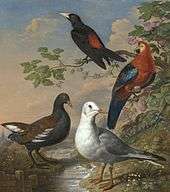
A hurricane in 1844 is said to have wiped out the population of Cuban macaws from Pinar del Río. Subsequent hurricanes in 1846 and 1856 further destroyed their habitat in western Cuba and scattered the remaining population. In addition, a tropical storm hit the Zapata Swamp in 1851. With a healthy macaw population, such events could have been beneficial by creating suitable habitat. However, given the species' precarious position, it may have resulted in fragmented habitat and caused them to seek food in areas where they were more vulnerable to hunting.[2]
The extinction date of the Cuban macaw is uncertain. Gundlach's sightings in the Zapata Swamp in the 1850s and Zappey's second-hand report of a pair on Isla de la Juventud in 1864 are the last reliable accounts.[2] In 1886, Gundlach reported that he believed birds persisted in southern Cuba, which led Greenway to suggest that the species survived until 1885.[15] Parrots are often among the first species to be exterminated from a given locality, especially islands.[2][19]
According to British writer Errol Fuller, aviculturalists are rumoured to have bred birds similar in appearance to the Cuban macaw. These birds, however, are reportedly larger in size than the Cuban macaw, having been bred from larger macaw species.[7]
References
- ↑ BirdLife International (2012). "Ara tricolor". IUCN Red List of Threatened Species. Version 2013.2. International Union for Conservation of Nature. Retrieved 26 November 2013.
- 1 2 3 4 5 6 7 8 9 10 11 12 13 14 15 16 17 18 19 20 21 22 Wiley, J. W.; Kirwan, G. M. (2013). "The extinct macaws of the West Indies, with special reference to Cuban Macaw Ara tricolor". Bulletin of the British Ornithologists' Club. 133: 125–156.
- ↑ Bechstein, J. H. (1811). Johann Lathams Allgemeine Übersicht der Vögel (in German). 4. Weigel und Schneider. p. 64.
- ↑ Rothschild, W. (1907). Extinct Birds. London: Hutchinson & Co. p. 51.
- ↑ Le Vaillant, F. O.; Barraband, Jacques; Bouquet (1801). "Histoire naturelle des perroquets". doi:10.5962/bhl.title.60852.
- ↑ Walters, M. (1995). "On the status of Ara tricolor Bechstein". Bulletin of the British Ornithologists' Club. 115: 168–170. ISSN 0007-1595.
- 1 2 3 4 5 Fuller, E. (2000). Extinct Birds. Oxford University Press. pp. 233–236. ISBN 0-670-81787-2.
- 1 2 3 4 5 Olson, S. L.; Suárez, W. (2008). "A fossil cranium of the Cuban Macaw Ara tricolor (Aves: Psittacidae) from Villa Clara Province, Cuba". Caribbean Journal of Science. 3. 44: 287–290. doi:10.18475/cjos.v44i3.a3.
- 1 2 3 Williams, M. I.; Steadman, D. W. (2001). "The historic and prehistoric distribution of parrots (Psittacidae) in the West Indies". In Woods, C. A.; Sergile, F. E. Biogeography of the West Indies: Patterns and Perspectives (pdf) (2nd ed.). CRC Press. pp. 175–189. ISBN 0-8493-2001-1.
- 1 2 3 Olson, S. L.; Maíz López, E. J. (2008). "New evidence of Ara autochthones from an archaeological site in Puerto Rico: a valid species of West Indian macaw of unknown geographical origin (Aves: Psittacidae)" (pdf). Caribbean Journal of Science. 44 (2): 215–222.
- ↑ Gala, M.; A. Lenoble (2015). "Evidence of the former existence of an endemic macaw in Guadeloupe, Lesser Antilles". Journal of Ornithology. 156 (4): 1061. doi:10.1007/s10336-015-1221-6.
- ↑ Turvey, S. T. (2010). "A new historical record of macaws on Jamaica". Archives of Natural History. 37 (2): 348–351. doi:10.3366/anh.2010.0016.
- ↑ Richmond, C. W. (1908). "Recent literature: Rothschild's 'Extinct Birds'". The Auk. 25 (2): 238–240. doi:10.2307/4070727. JSTOR 4070727.
- 1 2 3 Hume, J. P.; Walters, M. (2012). Extinct Birds. A & C Black. pp. 182–183, 400. ISBN 1-4081-5725-X.
- 1 2 3 Greenway, J. C. (1967). Extinct and Vanishing Birds of the World. American Committee for International Wild Life Protection. pp. 314–320. ISBN 0-486-21869-4.
- ↑ Clark, A. H. (1905). "The Greater Antillean Macaws". The Auk. 22 (4): 345. doi:10.2307/4069997. JSTOR 4069997.
- ↑ Mey, E. (2005). "Psittacobrosus bechsteini: ein neuer ausgestorbener Federling (Insecta, Phthiraptera, Amblycera) vom Dreifarbenara Ara tricolor (Psittaciiformes), nebst einer annotierten Übersicht über fossile und rezent ausgestorbene Tierläuse" (PDF). Anzeiger des Vereins Thüringer Ornithologen (in German). 5: 201–217.
- ↑ Bangs, O.; Zappey, W. R. (1905). "Birds of the Isle of Pines". The American Naturalist. 39 (460): 179–215. doi:10.1086/278509. JSTOR \ 2455378 \.
- ↑ Clark, A. H. (1905). "The Lesser Antillean Macaws". The Auk. American Ornithologists' Union. 22 (3): 266–273. doi:10.2307/4070159. JSTOR 4070159.
